Content
- The use of a horizontal bar for the spine
- What diseases of the spine can you do on the horizontal bar
- Contraindications for hanging on the bar
- With protrusion
- With scoliosis
- Does the horizontal bar help to increase growth
- What happens if you hang upside down on a horizontal bar
- Hanging rules
- Classes for osteochondrosis
- With a hernia
- With kyphosis
- With lordosis
- Video about the benefits of hanging on a horizontal bar
Experts recommend hanging on the horizontal bar for adults and children. The benefits of a simple exercise are to strengthen the spine and develop a grip on the hands. The complex has a number of contraindications, in the presence of which it is recommended to abandon the vertical hang.
The use of a horizontal bar for the spine
Hanging on a horizontal bar is beneficial, according to physiotherapists and neurologists. In people leading a sedentary lifestyle, diseases of the spinal column are often observed, often flowing into a chronic form. Pathologies are usually accompanied by the development of degenerative lesions of the vertebrae. A person experiences systematic or constant pain in the lumbar region, his mobility is limited.
In the absence of suitable treatment, in this case, the patient is prescribed an operation. Regular exercises on the horizontal bar allow you to strengthen the muscle frame and prevent curvature of the spine. The complex of physiotherapy exercises for degenerative lesions of the spinal column includes exercises on uneven bars or horizontal bars.
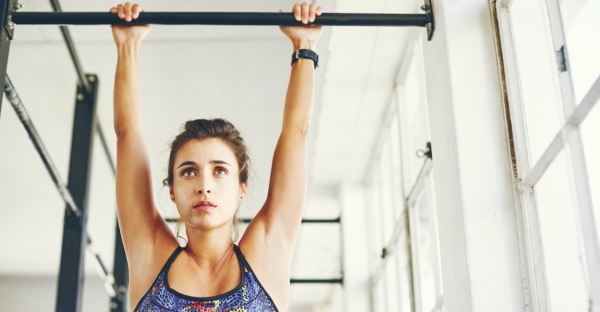
Hanging on this sports equipment allows you to:
- improve the flexibility of the spinal column;
- stabilize the position of the vertebrae;
- restore blood circulation;
- stop spasms and eliminate pain;
- take the load off the intervertebral discs;
- restore posture;
- strengthen the muscle frame.
To increase the flexibility of the spinal column, you need to do exercises regularly. Exercising on a horizontal bar on a daily basis helps to restore blood flow in the affected areas. Physiotherapy exercises can also be considered one of the most effective ways to prevent diseases of the spine. The risk of developing osteochondrosis, intervertebral hernias and protrusion in people with a sedentary lifestyle is higher.
What diseases of the spine can you do on the horizontal bar
Classes on the horizontal bar are useful not only for adults, but also for children. Exercise therapy helps prevent the curvature of the spinal column that occurs with a sedentary lifestyle.

The patient is prescribed to perform vertical hang for the following diseases:
| Name | Short description |
| Osteochondrosis | This disease is characterized by degenerative lesions of the intervertebral discs. Dystrophic processes are accompanied by compression of the discs, as a result of which they lose their elasticity. With osteochondrosis, a clamping of nerve endings is also observed. The person experiences severe pain, swelling is observed in the affected area. In the absence of adequate treatment, there is a high risk of complications that can lead to disability. |
| Kyphosis | The disease is characterized by curvature of the spine (physiological or pathological) in the anteroposterior direction (bending angle of 45 ° or more). In advanced cases, patients have kyphosis and scoliosis at the same time. The disease is quite dangerous. In the absence of adequate treatment, the patient may develop a hump, and spinal tuberculosis develops. |
| Lordosis | Curvature of the spine (pathological or physiological) is observed in the cervical or lumbar region. The degree of bending can vary depending on the type of pathology (45-60 °). The patient is in severe pain, his posture is impaired. In advanced cases, the patient is prescribed surgical intervention. |
The set of exercises and their duration are selected by a specialist. People with chronic diseases of the spine should exercise under the supervision of a trainer.
Contraindications for hanging on the bar
Hanging on the horizontal bar (the benefit of the exercise lies in the positive effect on the spine) can not only adults, but also children. Classes on the horizontal bar have a number of relative contraindications.
These include:
- obesity;
- inflammation of internal organs or systems;
- heart failure (including acute type).
When stretching muscles and ligaments, you cannot hang on the horizontal bar.
With protrusion
Protrusion is considered one of the absolute contraindications for exercising on the horizontal bar.
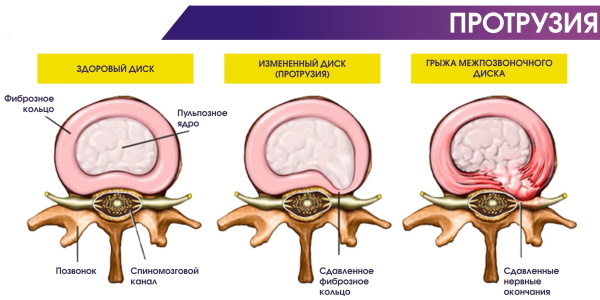
Depending on the localization, disc lesions are distinguished:
- lumbar spine;
- thoracic region;
- cervical spine.
The disease is characterized by a protrusion of the intervertebral disc. The degenerative process is accompanied by compression of the nerve endings. In the absence of adequate treatment, the fibrous ring ruptures, and prolapse of the intervertebral disc into the spinal canal is observed.
Classes on the horizontal bar are strictly prohibited with the following protrusions:
- Central. Bulging towards the center of the spinal canal. The degenerative process develops gradually, the disease in most cases is asymptomatic. Median protrusions do not require treatment.
- Side. A bulge is observed on the left or right side of the spinal column. In this case, an increased load is placed on the spinal cord. The disease can also be asymptomatic.
- Posolateral. The intervertebral disc protrudes back and sideways to the spinal cord. If the degenerative process does not have any physical effect on the nerve endings, then the pathology is asymptomatic.
- Back. The intervertebral disc protrudes from the abdomen to the back. The protrusion puts pressure on the spinal structure, as a result of which there are disruptions in the functional activity of the pelvic organs and severe pain.
- Circular. The intervertebral disc protrudes evenly from all sides. This is the most dangerous and common protrusion. In the absence of adequate treatment, the spinal nerves are pinched.
- Diffuse. The intervertebral disc protrudes unevenly and repeatedly. The protrusion is characterized by numerous lesions. The risk of complications is high.
Classes on the horizontal bar are prohibited, regardless of the stage of protrusion formation. The disease often occurs against the background of obesity, physiological age-related changes and diseases of the spinal column.
With scoliosis
Scoliosis is understood as a persistent deformity of the spinal column, characterized by a curvature to the side. In the absence of adequate treatment, deformation of the pelvic and chest bones occurs, which leads to impaired functional activity of internal organs. Scoliosis cannot be considered a violation of posture; it is impossible to cure the disease with the help of physical exercises. Most often, pathology is diagnosed in children and adolescents.

There are several main types of scoliosis (due to development):
- hysterical - is rare, develops against a background of stress or depression;
- compensatory - develops when the right or left leg is shortened;
- reflex - appears when the patient takes an uncomfortable posture against the background of severe pain syndrome;
- sedimentary - develops in case of posture disorders.
Any exercise on the horizontal bar (including vertical hanging) is strictly prohibited for patients suffering from the following types of structural scoliosis:
- osteopathic - the cause of development is considered to be congenital anomalies of the spinal column;
- metabolic - caused by a deficiency of certain substances in the body or provoked by metabolic disorders;
- neurogenic - the cause of development is considered poliomyelitis, syringomyelia, neurofibromatosis;
- myopathic - pathology develops against the background of muscular dystrophy and myopathy.
Classes on the horizontal bar are contraindicated in cicatricial and traumatic scoliosis. In the first case, the patients are diagnosed with deformation of soft tissues, in the second - lesions of the musculoskeletal system.
Does the horizontal bar help to increase growth
According to reviews, with the help of exercises on the horizontal bar, you can increase the height by 5-10 cm. To achieve a positive result, it is necessary to alternate hanging in a relaxed state with intense exercise. You cannot jump off the horizontal bar: it is recommended to put your feet on a chair and gently get off it. The exercises are performed in 3 stages. You cannot swap them or skip complexes.
Exercises are classified by difficulty:
-
First stage. You need to hang on the horizontal bar, alternating the bottom grip and the top grip. Then swing to the side, back and forth. Bend your legs at the knees, straighten, throw your head back and try to bend slightly. At the final stage, you can turn the body and pull the legs up to the stomach.

- Second phase. To practice on a horizontal bar, you will need a chair. Alternating the grip from below and from above, the right leg is placed on a support, the left leg is lowered. You need to try to pull up on the horizontal bar on the right and left legs in turn. Legs bent at the knees are straightened at right angles and swing. Then they are pulled to the stomach, straightened and in this position pulled up on the horizontal bar so that the crossbar is at eye level.
- Third degree. This complex is suitable only for trained people. At the initial stage, you will need a safety net. You need to bend your legs at right angles and perform the scissors exercise. Then you need to try to raise the legs brought together to each other to the crossbar so as to touch it with your socks. When pulling up, throw your head back and bend over, touching the horizontal bar with your stomach. At the final stage, you need to pull yourself up to the level of the chin with your legs bent at a right angle.
Only children and adolescents can increase height with the help of a horizontal bar.
What happens if you hang upside down on a horizontal bar
Hanging on the horizontal bar (the benefits of the complex are based on the development of the muscle frame) can be upside down.
Inversion therapy using gravity boots can correct a number of problems:
- Restoration of joint flexibility. With regular exercise, pain in the lower extremities becomes less pronounced.
- Posture correction. In reverse hanging, the spine is extended to restore posture.
- Eliminate stress. When using gravity boots, blood circulation is restored, more oxygen enters the cells.
- Elimination of spasm. With reverse hanging, the pressure on the nerve endings and discs decreases, pain is eliminated.
Hanging upside down is possible with ischemia of intervertebral discs, lordosis, kyphosis and osteochondrosis. Exercises are selected by a specialist. Their intensity and nature directly depend on the patient's diagnosis.

It is strictly forbidden to use gravity boots for people suffering from:
- being overweight;
- diseases of the organs of vision (retinal detachment, glaucoma);
- pathologies of the heart and blood vessels.
Exercises on the horizontal bar are contraindicated for pregnant women (regardless of the trimester). Relative limitations also include osteoporosis and spinal injuries. In the initial stages of training, it is best to exercise under the supervision of a trainer.
Hanging rules
To minimize the risk of injury when exercising on the horizontal bar, you must adhere to a number of rules. People who do not have basic skills in working with a crossbar need to work with a trainer for the first time.
The set of exercises is aimed at preventing the development of osteochondrosis of the thoracic and lumbar spine. In this case, experts recommend performing a full hang. Poluvis is indicated for patients with progressive osteochondrosis. During the exercise, the person does not lift his legs off the ground.
Rules for the implementation of the training complex:
- Warm up. It is performed within 3-5 minutes. in order to warm up muscle fibers.
- Accessories. To practice on a high horizontal bar, you will need a stool or step.
You cannot jump onto the crossbar. The grip must be neat; it is performed while standing.
The rules for performing a full hang:
- the crossbar is grasped with a direct grip, fingers are located away from you, hands are shoulder-width apart;
- the legs do not touch the ground, the body is relaxed;
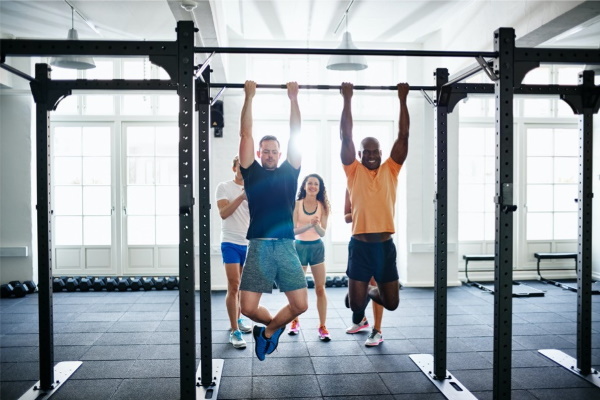
- the head is stationary.
The position is fixed for 20-30 seconds, after which the legs are lowered onto a chair. It is recommended to perform 2-3 repetitions. With full suspension, the lumbar and thoracic regions should be completely relaxed.
Half-vis is performed kneeling on a special simulator. The legs should be relaxed, the body is slightly lowered, the limbs are bent. 2-3 repetitions are performed, the position is fixed for 20-30 seconds. Exercise helps relieve stress on the spinal column.
The rules for performing a reverse hang using gravity boots:
- Shoes are fixed on the ankles, standing on a flat surface. It is important that the attachments are securely fixed.
- After the athlete has tightened the straps, he fixes his legs to the bar with special hooks. You can use a hand lever, an inclined ladder or a horizontal bar.
- Slowly lower the body down, hang, completely relaxed for 3-5 minutes.
Experts recommend wearing a tight-fitting tracksuit. In the ankle area, boots can rub the skin, so training is carried out in leggings. More experienced athletes can do up to 3 sets.
Classes for osteochondrosis
Hanging on the horizontal bar (the benefits of the exercise are obvious in osteochondrosis) is needed for people suffering from joint diseases. The disease is characterized by damage to the discs located between the vertebrae. It is possible to carry out training on the crossbar only at the initial stages of the formation of osteochondrosis.
In the process of performing the complex, you should try not to load the cervical spine. The intensity and nature of the training is selected by the therapist, traumatologist or orthopedist.
Physical activity is contraindicated if the patient has the following concomitant diseases:
- pathology of the respiratory system, blood vessels and heart (arrhythmia, defects, asthma of the bronchial type);
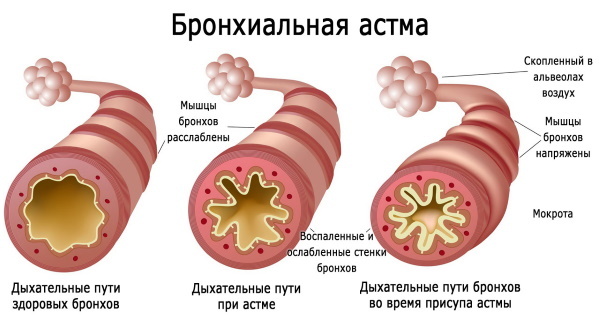
- epileptic seizures or syncope;
- the growth of benign or malignant neoplasms (regardless of localization);
- pathologies of infectious etiology, characterized by temperature jumps and fever;
- compression of the spinal column, inflammation of the vessels of the spine or their blockage.
Any surgical interventions on the spine can be considered an absolute contraindication to training on the horizontal bar. With osteochondrosis, hanging on the bar allows you to normalize blood supply and eliminate pain.
Can:
- pull up with two or one hands;
- hang on the horizontal bar.
Full vis with progressive osteochondrosis is not recommended. During training, you should not take your legs off the ground.
With a hernia
Hanging on the horizontal bar (the benefits of the complex for intervertebral hernias have been proven by scientific research) can be carried out in compliance with the basic safety rules. The protrusion, in the absence of adequate treatment, is transformed into a hernia. Pathology is characterized by clamping of nerve endings and blood vessels. Systematic exercises on a sports equipment allow you to restore blood flow, strengthen the muscle frame and saturate cells with oxygen.
Regular training on the horizontal bar promotes faster recovery of muscle tissue and bones. The process of removing salts from the joints is also accelerated. With full hanging on the horizontal bar, the spine is stretched (especially the lumbar and thoracic regions). With cervical hernias, you must refrain from exercising on sports equipment. You can train on a horizontal bar if the disease is mild. In this case, the nerve nodes are not compressed, the hernia does not grow.
The main contraindications include:
- periods of exacerbation of pathology;
- sequestration (advanced forms of intervertebral hernia);
- inflammatory processes occurring inside the spinal column;
- prolonged, sharp pain that occurs in advanced cases.
In case of intervertebral hernias, it is better to avoid rotational and axial loads. Twisting is strictly prohibited.
Basic rules of training on the horizontal bar:
- pull-ups and any other exercises should be slow and smooth;

- if pain or other discomfort appears, the training should be stopped immediately;
- classes should be regular, up to -4 repetitions can be performed per day;
- loads increase gradually, with the permission of the attending physician.
Pull-ups and full hanging on a horizontal bar are best done outdoors or in a well-ventilated area.
With kyphosis
Kyphosis is characterized by curvature of the thoracic (upper) section. Depending on the type, the acquired and hereditary forms are distinguished.
The main reasons for the development of the disease can be considered:
- weakness of the muscle frame;
- posture disorders;
- spinal injury;
- rickets;
- spinal tuberculosis.
There are no absolute contraindications to exercising on the horizontal bar with kyphosis.
The patient may be prohibited from training in the presence of concomitant pathologies:
- diseases of blood vessels, heart and respiratory organs (asthma of the bronchial type, arrhythmia, acute insufficiency, atherosclerosis, thrombosis);
- diseases of the organs of vision (glaucoma, retinal detachment);
- degenerative lesions of the spinal column, accompanied by inflammation;
- osteoporosis;

- rehabilitation after surgery.
At the initial stage, you need to practice half-vis. The duration of the exercise varies between 7-15 minutes. in a day. You can perform up to 3 approaches. During training on the crossbar, you must not overload the lumbar region. During pull-ups, a medium or small grip is used.
In this case, the load on the spinal column will be evenly distributed. Reverse grip is prohibited. With grade 3 kyphosis, experts recommend using weighting agents during training. All movements should be smooth: this will minimize the risk of vertebral injury.
With lordosis
With lordosis, there is a curvature of the spine in the lumbar region and cervical spine. Most often, pathology is diagnosed in children immediately after birth.
Disease classification:
- Primary. The main reason for the development of this form of lordosis is considered to be various pathological processes occurring in the spinal column. This type can be triggered by inflammatory diseases, displacement of the vertebrae or intervertebral hernias.
- Compensatory (pathological, secondary). This form of the disease develops against a background of injury to the cervical spine during delivery. Occurs in women who regularly wear high-heeled shoes.
By localization, lordosis is distinguished:
- lumbar spine;
- cervical spine.
According to the form, they are distinguished:
- hyperlordosis;
- hypolordosis;
- physiological lordosis.
With a curvature of the spine, the patient complains of rapid fatigue, nervousness, pain in the neck or lower back. Exercises on the horizontal bar help to stretch muscle fibers and the spine. It is strictly forbidden to perform deflections on a sports equipment. In addition to hanging completely, you can pull your knees up to your stomach. During the day, it is recommended to perform up to 2-3 approaches. The duration of the exercises varies between 5-10 minutes.
Basic rules for conducting training:
- you cannot perform twisting, swinging legs, turning the body on the horizontal bar;
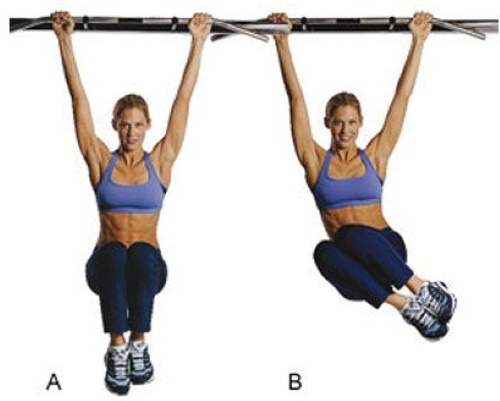
- at the initial stage, full hanging is performed with an emphasis on a stool;
- when pulling up, use a medium grip.
During training, it is impossible to overload the lumbar cervical spine. The load on the spinal column should be evenly distributed. People suffering from spinal diseases need to be careful when hanging on the horizontal bar. The benefit of exercise is to improve the patient's well-being: with regular exercise, pain becomes less pronounced, and efficiency increases. The training complex is selected by a specialist depending on the patient's diagnosis.
Video about the benefits of hanging on a horizontal bar
What is the use of hanging on a horizontal bar:



